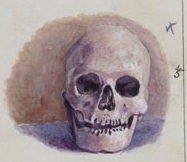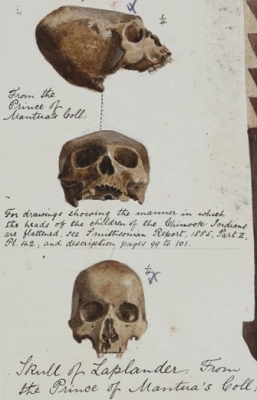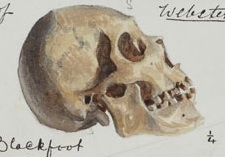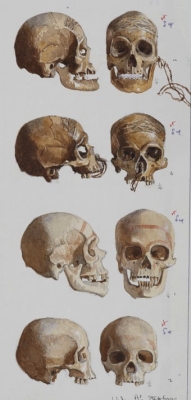To search the RPR site click here
Artistic Influences upon Pitt-Rivers:
W.H. Wesley: 'XII On the iconography of the skull', Memoirs read before the Anthropological Society of London 1865-6 Vol II, London 1866 page 189 et seq. [1]
Pitt-Rivers joined the Anthropological Society in 1865 so he must have had an opportunity to either hear this paper when it was read at a meeting on 20 February 1866, or read it in the Memoirs. Although its title suggests it is purely concerned with the illustration of physical anthropological specimens, its conclusions and suggestions could easily have been used when illustrating artefacts. The influence of this source on Pitt-Rivers has not been verified. The lengthy discussion about this paper is given at Journal of the Anthropological Society of London Vol. 4, (1866), pp. cxx-cxxvi. See here for the link to the discussion available through jstor [http://www.jstor.org/stable/3025384], and here for a copy of the relevant volume of Memoirs available via googlebooks.
'... I shall endeavour to point out the best method of drawing the cranium ...
There are two methods of delineating natural objects upon a plane surface; the one we may call 'the geometrical' ... and the ordinary 'perspective' method of delineation.
Drawings upon the geometrical system, are simply elevations or plans not taken from one point of sight; the line of sight being always perpendicular to the plane of the projection. Dr Lucae's instrument for drawing upon this principle, consists of a plate of glass placed over the object to be delineated, and over this page an apparatus by which the eye is always perpendicularly above the plate, while the drawing is being traced upon it. In these drawings, therefore, there is no perspective, and no foreshortening; everything is represented as it really is, and not as it appears to the eye.
The great advantage claimed for the geometrical method, is that drawings made upon that system are not only comparable with one another, but measurable. This is, however, only true to a certain extent; for geometrical drawings are only measurable upon lines parallel to the plane of the projection, and perpendicular to the line of vision. It must be remembered, also, that perspective drawings are measurable upon the most important plane of all, viz., the central line of the skull. All planes nearer to the eye than this line, are in perspective drawings increased, and all planes more remote from the eye are reduced in size.
Still it may be urged, that geometrical drawings are much more capable of measurement than drawings made on the ordinary perspective method, and this is undoubtedly the truth. If we have a sufficient number of geometrical elevations from different points of view, we can obtain from them all the principal measurements without referring to the original skull and perhaps even more readily.
This appears to be a great advantage which the geometrical method possesses, but I believe it to be more apparent than real. We have only to ask ourselves, What is the end aimed at in drawing the skull, and what is the use of such delineations? Without doubt, their use is to supplement the tables of measurement ... The only question, then, about the two methods of drawings is, which best subserves this end? I believe, without question, the perspective drawing. It is true that the geometrical drawings give accurate measurements, but these are also supplied in the measurement tables. Geometrical drawings do not give the general impression of the skull which tables of measurement cannot give, and to supply which is the only end for which drawings of the skull are required. These delineations are required as substitutes for the examination of the skull itself...
... The impression produced upon the eye by an object is that of a perspective drawing, and not of a geometrical elevation; since in observing any object, those parts nearer the eye appear larger than they are in reality, and those parts further removed appear less; thus we have fore-shortening, and those effects which we call perspective.
The fault most frequently committed in drawing the skull, is a want of attention to its position. We sometimes see skulls represented in what is called three-quarters face; that is the view most frequently given by artists in ordinary portraits, but it is most ill-adapted for scientific purposes. ...
We frequently see drawings of the cranium which are almost useless, in consequence of inattention to their position in regard to elevation. If the skull is inclined forward, the forehead will appear larger in the front view than it should be, and the chin and lower part less, and vice versa. ... [Wesley goes on to suggest positions best suited to the skull when being drawn]
Leaving the interior of the skull out of consideration, five views are required to represent it thoroughly; the side or profile, the top or vertical view, the front, the back, and the base view. ...
That the delineations may be comparable with one another, the distance between the eye and the object should always be the same. A drawing of a skull or other object taken from a distance of six feet is not perfectly comparable with one taken from a distance of three, since the amount of foreshortening is much greater in the latter.
For scientific purposes, elaborately shaded drawings are not required; indeed, pure outlines are far preferable to drawings in which any details are obscured by the shading.
For the purposes now under consideration, drawings should always be made to some fixed scale. Half and quarter sixes are most to be recommended for drawings of skulls. They have the great advantages that their measurements are easily comparable with one another, and with those of the original skull. Third size is inconvenient because it is not easily comparable, especially with drawings on the scale of one-fourth. In many cases, quarter size drawings are sufficiently large, while if more detail is required, half size will generally show it, and is in many respects more convenient than the full size of nature.
It is not necessary for me to say anything on the use of the camera lucida, but I should mention that this instrument is indispensable, both for the great saving of labour and for the accuracy of outline obtained by its employment.
A few words may not be out of place here upon the application of photography to craniology. ... Too great attention cannot be paid to the lighting of photographs, since in a photograph, as in nature, there is no outline. Everything is defined by the shading ... [Wesley discusses the disadvantages of light coming from various different angles]
It does not seem to me probable that photography will ever supercede drawing for scientific purposes. For portaits of living persons, of course photography is admirably adapted, but for skulls it has objections which are scarcely to be overcome. If the lighting of the picture be perfect, it is still a disadvantage that the photograph renders every minute detail with absolutely certain fidelity. Stains and imperfections of the bones, cracks and holes, cannot be omitted in the photograph, and often much obscure its clearness, while if the operator is not skilful, these accidental details will often be the most distinctly rendered. A really accurate camera lucida drawing is far more valuable than most photographs, however they may excel it in artistic effect. Science owes much to photography, and photography is no doubt capable of much improvement; but I still think that the work of the artist will never be altogether dispensed with, nor be superseded by any merely mechanical process.
It is easy to see how this paper might have influenced Pitt-Rivers as Wesley's comments on drawing skull accurately are also completely applicable to drawing artefacts into catalogues as Pitt-Rivers caused to be done.[2]
Notes:
[1] I am not entirely sure who W.H. Wesley was, it is probable he was William Henry Wesley (1841-1922), Assistant Secretary to the Royal Astronomical Society, who wrote several entries for the Dictionary of National Biography according to here. The dates certainly match and, perhaps surprisingly, there were several other astronomers in the Anthropological Society / Institute. According to his obituary:
'He was gifted with keen artistic tastes, and possessed great skill in accurate drawing and delineation, he rapidly became an expert engraver. In all his spare time he cultivated his drawing by making studies at the British Museum. His conspicuous ability in this direction soon brought him into notice, and in 1862 an introduction to Professor Huxley resulted in his drawing and engraving many illustrations for him. This was followed by much work for ... Prof. Flower, Sir John Lubbock, Dr Barnard Davis and many other biologists.'
In the same source he is quoted as being described as a 'master of lithographic art', and described as making 'many delightful water-colour drawings'. See 'Obituary: William Henry Wesley', The Observatory, Vol. 45, p. 354-355 (1922).
[2] Please note that Pitt-Rivers did not contribute to the recorded discussion about this paper.
Note: I have illustrated this page with some of the drawings of skulls from the catalogue of the second collection, just to show how they were done there by the various artists. I think that Wesley's comments can be read in a wider context as relating to the recording of material culture as well as human remains.
Transcribed by AP as part of the Rethinking Pitt-Rivers project September 2010







